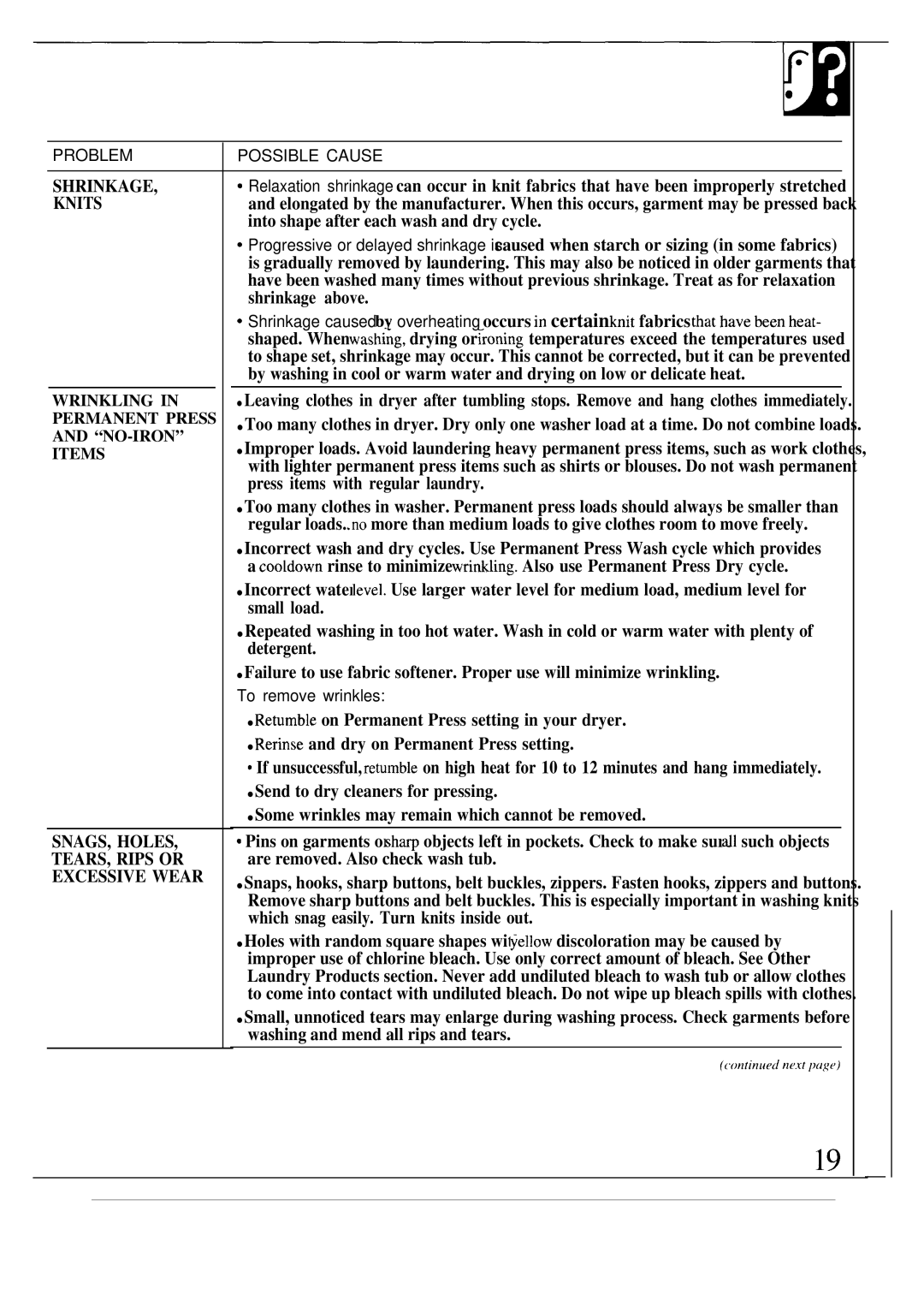
PROBLEM |
|
| POSSIBLE CAUSE | |
|
|
|
|
|
SHRINKAGE, |
|
| Relaxation shrinkage can occur in knit fabrics that have been improperly stretched | |
KNITS |
|
| and elongated by the manufacturer. When this occurs, garment may be pressed back | |
|
|
|
| into shape after each wash and dry cycle. |
|
|
|
| Progressive or delayed shrinkage is caused when starch or sizing (in some fabrics) |
|
|
|
| is gradually removed by laundering. This may also be noticed in older garments that |
|
|
|
| have been washed many times without previous shrinkage. Treat as for relaxation |
|
|
|
| shrinkage above. |
|
|
|
| Shrinkage caused by overheating occurs in certain knit fabrics that have been heat- |
|
|
|
| shaped. When washi~g, drying or ironing temperatures exceed the temperatures used |
|
|
|
| to shape set, shrinkage may occur. This cannot be corrected, but it can be prevented |
|
|
|
| by washing in cool or warm water and drying on low or delicate heat. |
WRINKLING IN |
|
| ● Leaving clothes in dryer after tumbling stops. Remove and hang clothes immediately. | |
PERMANENT PRESS |
|
| ● Too many clothes in dryer. Dry only one washer load at a time. Do not combine loads. | |
AND |
|
| ||
|
| ● Improper loads. Avoid laundering heavy permanent press items, such as work clothes, | ||
ITEMS |
|
| ||
|
| with lighter permanent press items such as shirts or blouses. Do not wash permanent | ||
|
|
|
| |
|
|
|
| press items with regular laundry. |
|
|
|
| ● Too many clothes in washer. Permanent press loads should always be smaller than |
|
|
|
| regular loads.. .no more than medium loads to give clothes room to move freely. |
|
|
|
| ● Incorrect wash and dry cycles. Use Permanent Press Wash cycle which provides |
|
|
|
| a cooldown rinse to minimize wrinMing. Also use Permanent Press Dry cycle. |
|
|
|
| ● Incorrect water level. Use larger water level for medium load, medium level for |
|
|
|
| small load. |
|
|
|
| ● Repeated washing in too hot water. Wash in cold or warm water with plenty of |
|
|
|
| detergent. |
|
|
|
| ● Failure to use fabric softener. Proper use will minimize wrinkling. |
|
|
|
| To remove wrinkles: |
|
|
|
| ● Retumble on Permanent Press setting in your dryer. |
|
|
|
| ● Rerinse and dry on Permanent Press setting. |
|
|
|
| “ If unsuccessful, retumble on high heat for 10 to 12 minutes and hang immediately. |
|
|
|
| ● Send to dry cleaners for pressing. |
|
|
|
| ● Some wrinkles may remain which cannot be removed. |
|
|
|
| |
SNAGS, HOLES, |
|
| Q Pins on garments or shq objects left in pockets. Check to make sure dl such objects | |
TEARS, RIPS OR |
|
| are removed. Also check wash tub. | |
EXCESSIVE WEAR |
|
| ● Snaps, hooks, sharp buttons, belt buckles, zippers. Fasten hooks, zippers and buttons. | |
|
|
|
| |
|
|
|
| Remove sharp buttons and belt buckles. This is especially important in washing knits |
|
|
|
| which snag easily. Turn knits inside out. |
|
|
|
| ● Holes with random square shapes with yellow discoloration may be caused by |
|
|
|
| improper use of chlorine bleach. Use only correct amount of bleach. See Other |
|
|
|
| Laundry Products section. Never add undiluted bleach to wash tub or allow clothes |
|
|
|
| to come into contact with undiluted bleach. Do not wipe up bleach spills with clothes. |
|
|
|
| ● Small, unnoticed tears may enlarge during washing process. Check garments before |
|
|
|
| washing and mend all rips and tears. |
